When does a business lookup call routing? Here’s when:
- They’re ready to create a seamless customer experience
- They want to build a workflow that works for their call center agents.
- They want to improve their call center performance, which ultimately reflects on their brand and sales numbers.
This article explores call routing and addresses the growth areas above.
What is call routing?
Prolonged wait times to connect with an agent and unsuccessful interactions with the first agent negatively impact customer satisfaction and goodwill, as indicated by Levin in 2007. Call routing helps call centers queue and distribute calls based on pre-defined criteria or rules, to increase customer satisfaction and improve call center performance.
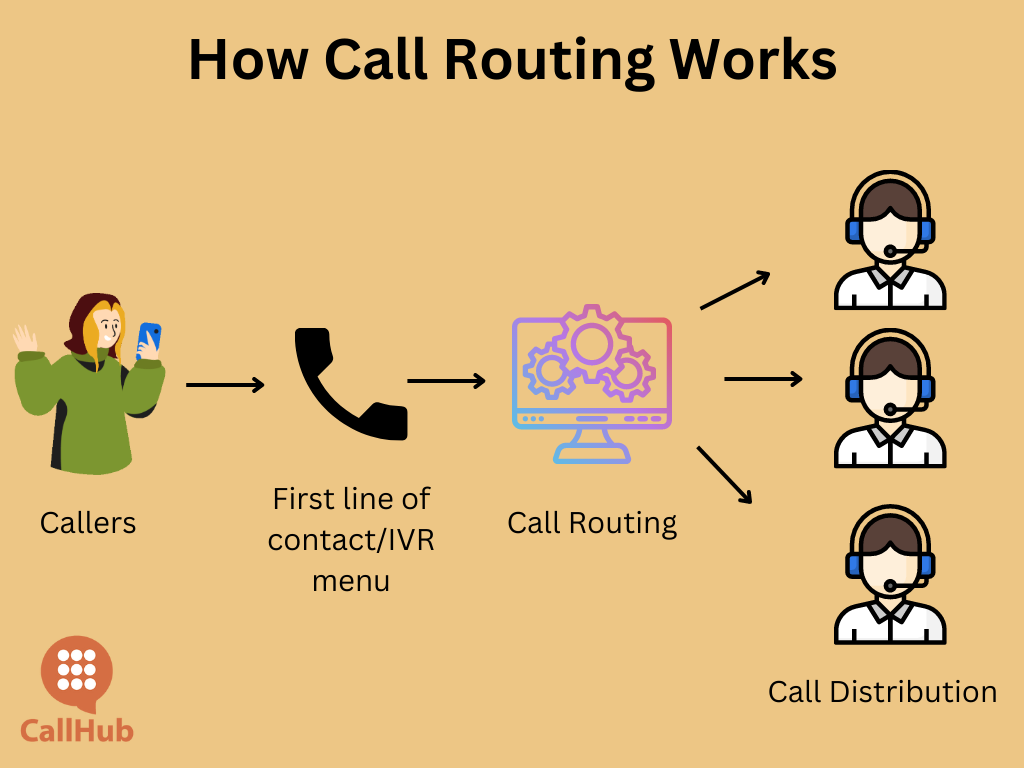

An incoming call to the call center is redirected to a queue based on specified criteria that could include–
- Location of the caller,
- Language preference,
- Department they want to connect with,
- Agents with expertise in resolving that issue and more.
Learn more about call routing and how it can impact your call center.
Call routing vs. call forwarding: What’s the difference?
73% of individuals consider valuing their time as the paramount factor for a company to deliver satisfactory online customer service. This underscores the critical importance of efficiency and timely responsiveness in meeting customer expectations and ensuring a positive online service experience.
The goal of both call forwarding and call routing is the same – to connect the caller to the next available agent. This commonality is why many people confuse them to be the same.
So what is the difference between call forwarding and call routing?
Call routing queues and route callers to the next available or the best agent to resolve their concerns. It can connect to different departments or agents within the same department based on a set of rules.
On the other hand, call forwarding ensures that calls are forwarded to another number or a group of numbers that connect to the same agent. For example, if the agent is unavailable on a landline, the call is forwarded to their mobile phone, home phone, etc., depending on which numbers have been added to the system.
To summarize, call routing helps to reduce average handling time and connect the customer to an agent in the shortest time possible. Call forwarding ensures that a customer does not have to dial multiple numbers to reach an agent. They have access to an agent at any time, any place.
What are the different ways for call routing?
Depending on your business needs, you can route calls in several different ways.
For example, if your priority is ensuring every agent gets the same number of calls, then you might choose uniform call routing. However, you might consider skill-based routing if you prefer customers to be routed to agents with specific expertise.
Let’s explore these call routing methods to determine the best one for you.
Round-robin call routing
Round-robin or circular call routing is a turn-based routing system. It sends calls to an agent only when the agent before them has received a call.


In other words, calls are routed in an order, starting with the first agent. The cycle restarts when the last agent receives a call.
Round-robin call routing is great for sales teams that want to ensure every agent gets an opportunity to make a sale. Incoming customers are distributed equally among agents.
Regular call routing
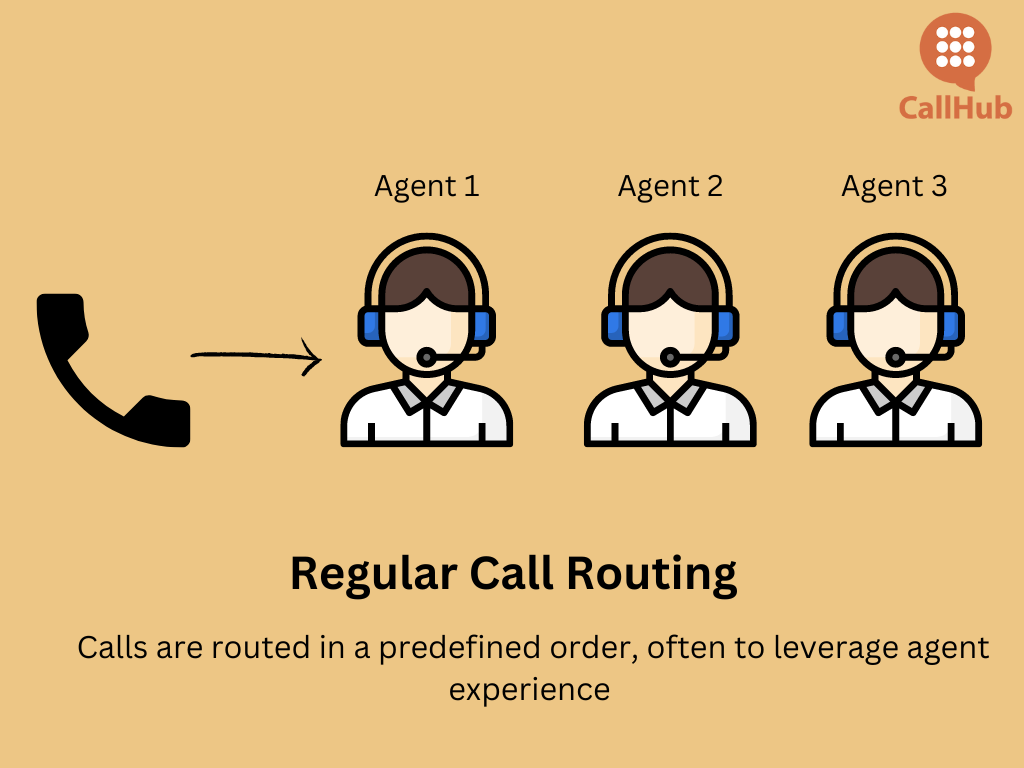

If you wish to route your calls in a fixed order, then regular call routing is for you. Calls always go to the first agent in the order. Only when this agent is busy on another call is the call routed to the next agent. When both agents are engaged, the call goes to the third agent, and so on.
This call routing type takes advantage of the skill level and experience of the agents. For example, your call center can first assign new agents to deal with routine queries and more experienced agents later to solve more complex issues.
Uniform call routing
As the name suggests, uniform call routing ensures that all agents receive calls uniformly. The system assigns the next incoming call to an agent with the longest idle or available time.
For example, if Agent A has been inactive for 15 minutes, but Agent B has been idle for 8 minutes, the next call will be assigned to Agent A.
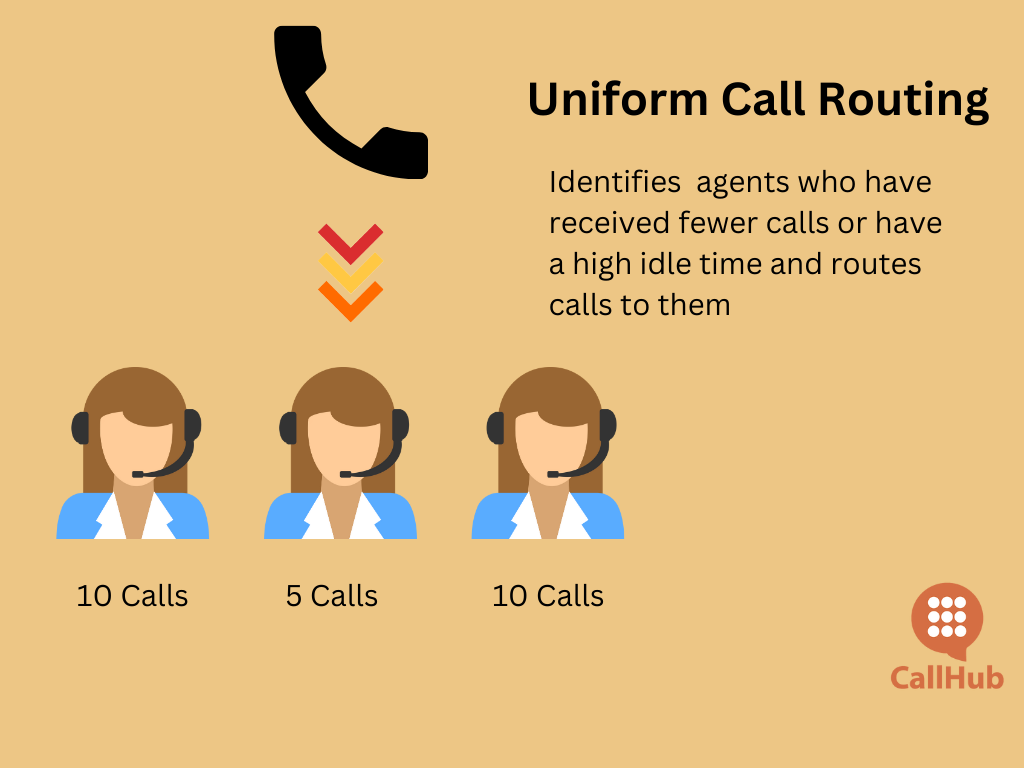

Uniform call routing also identifies the agents who have not received many calls and assigns more calls to them.
This call-routing method ensures you get the most out of every agent you hire. It avoids overwhelming a few agents with a large call volume and avoids underperformance by others.
Simultaneous call routing


If speed is essential to your business, then simultaneous call routing is perfect for you. Under this call-routing method, incoming calls are routed to all agents. The first agent to pick up the call handles it.
This way, a customer is served as fast as possible.
Weighted call routing
This call routing type allows managers to set weightage or ratios in which calls are to be routed to agents. For example, a manager can assign 45% of calls to Agent A, 20% to Agent B, and 35% to Agent C.
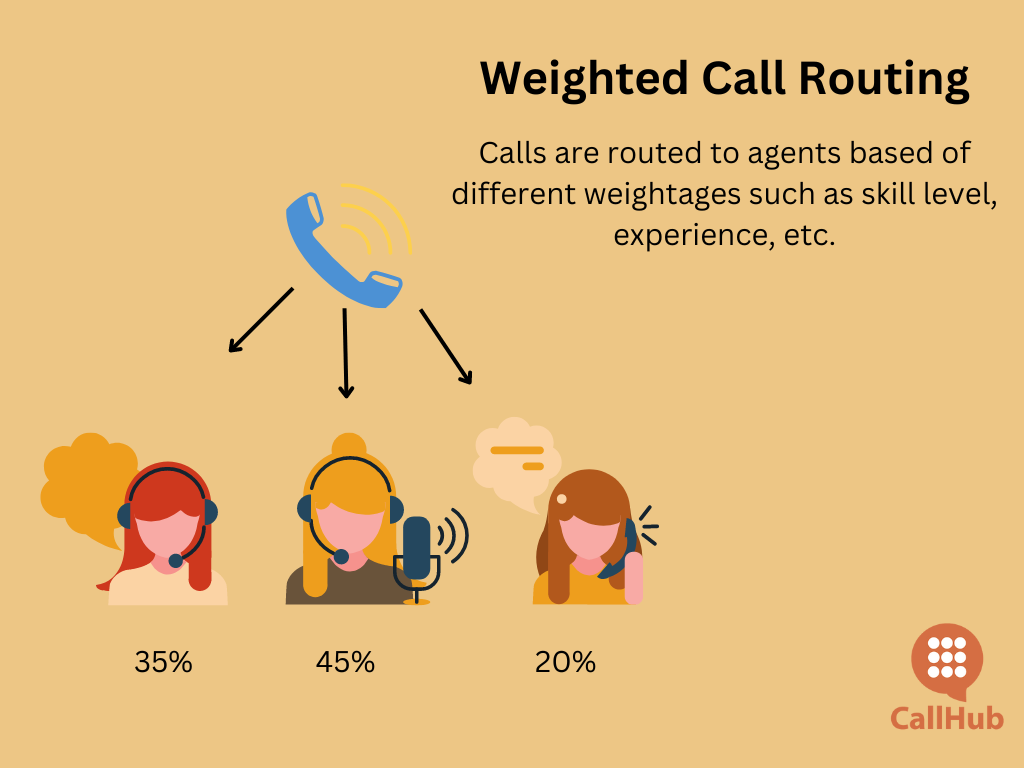

Weighted call routing helps when managers want to train new agents without burdening them with a bulk of calls when they start. Alternatively, managers might want their most experienced agents to receive more calls.
Predictive Behavioral Call Routing
Also known as intelligent routing, predictive behavioral call routing uses Artificial Intelligence (AI) to route calls to the best agent to handle an inquiry.
AI tools determine factors such as the caller’s
- preferred communication channels
- purchase history,
- previous communications,
- behavior patterns, or
- customer profile…
… to understand which agent to connect with.
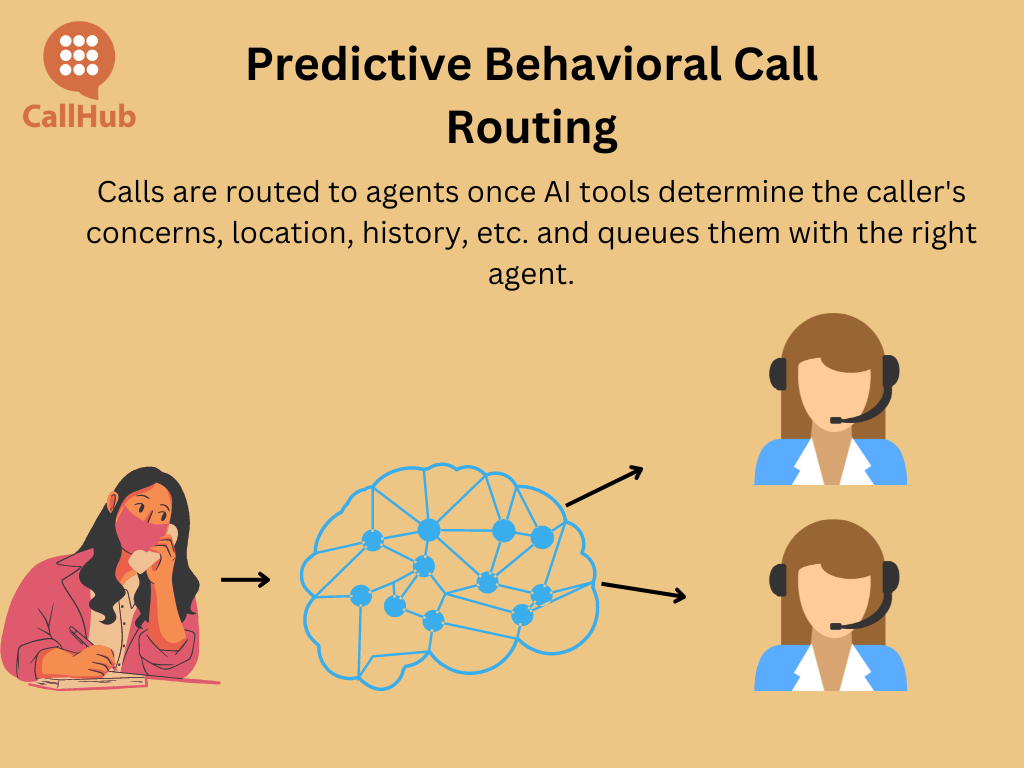

This call routing method can have a significant impact on your First Call Resolution (FCR), Average Handle Time (AHT), Customer Satisfaction (CSAT), and Net Promoter Score (NPS) metrics.
Time-based call routing
A geographically diverse or hybrid call center benefits from time-based call routing. It routes calls to agents based on their time zones or work hours.


With time-based routing, you do not have to worry about receiving calls outside of work hours. Your call routing system uses metrics such as agent location and allotted business hours to route calls to them.
VIP call routing
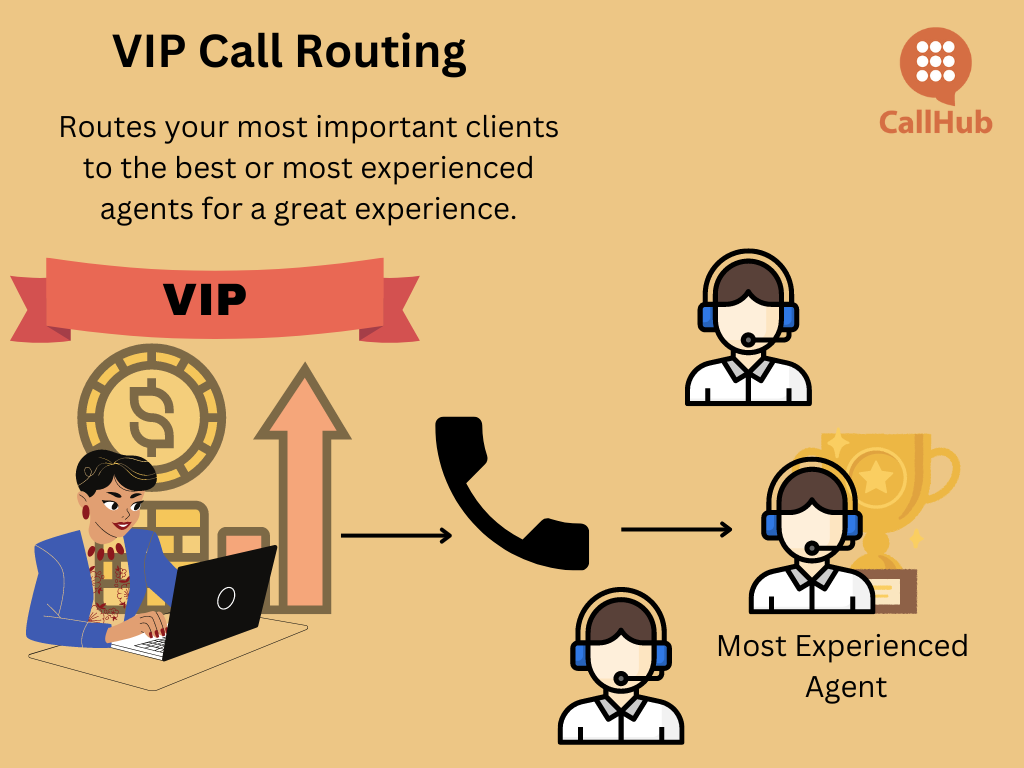

The VIP call routing system enables you to route your most premium clients to your most experienced agents. Your VIP clients could be—
- High net-worth individuals,
- Big ticket clients
- Long-term clients
- The Board of Directors of your company.
If you want to rest well knowing these clients are well taken care of, then this call routing option is excellent for you.
Skill-based call routing
Skill-based call routing allows customers to connect with an agent most equipped to handle their query. Customer inquiries are first collected through an IVR system.
You can present them with options for each number on the dial pad (Ex: Dial 1 for the billing department, Dial 2 to speak to an agent, etc.). Once they enter these data points, they are routed to the appropriate department or agent.
For example, if a customer wants to talk about their billing preferences, the system ensures that calls are routed to an agent who knows about billing issues.
According to SQM’s research, agents with specialized skill sets tailored to handle specific call types exhibit a 5% to 15% higher First Call Resolution (FCR) performance compared to generalist agents who can handle most or all call types. This underscores the effectiveness of aligning agent expertise with specific call requirements in achieving improved FCR outcomes.
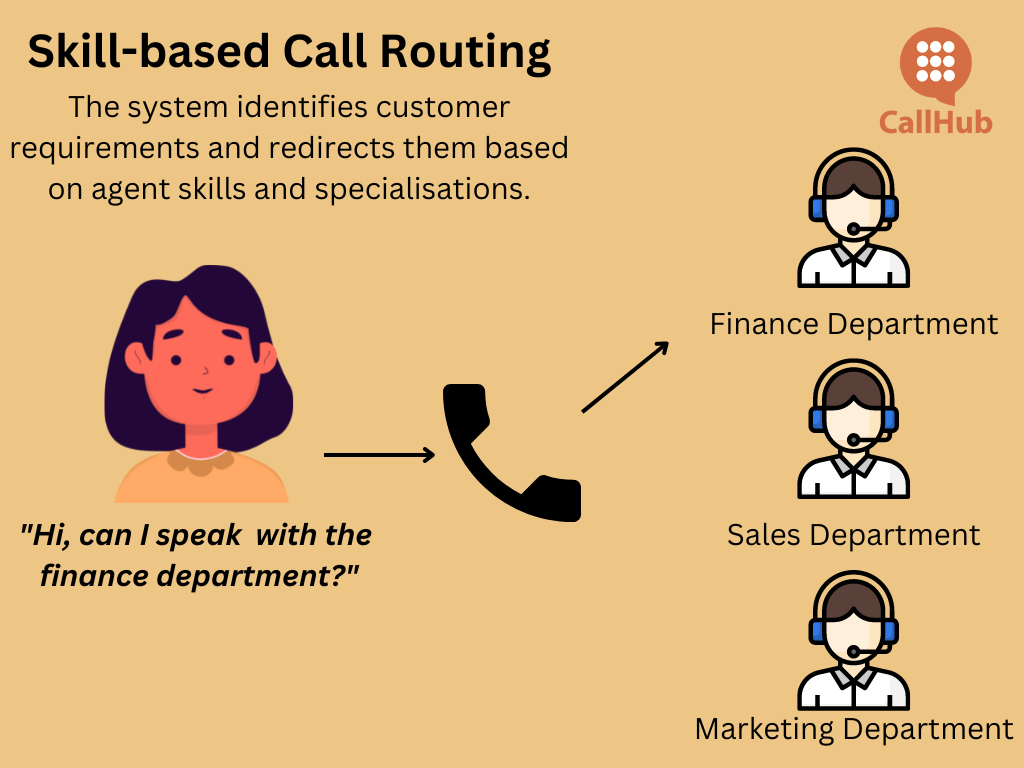

Now that we know the different routing types, let’s look at how setting up a routing process can benefit your business.
Benefits of call routing
Call routing has a two-fold benefit for customers and the organization. Let’s explore how call routing methods create a win-win situation.
Benefits for the customer:
Any call center would aim for customer satisfaction. Here’s how call routing practices help the customer:
- Reduced waiting time: A quick connection with agents ensures customer concerns are resolved promptly.
- Avoid unpleasant customer experiences: Customers can avoid calling back multiple times for a resolution, getting connected to many agents for one solution, etc. Understanding customer concerns and routing them to the right agent helps with faster resolutions. A high first-call resolution rate also impacts your customer satisfaction metrics.
- Provides an option for self-service: If you set up an IVR menu before call routing, you can provide automated solutions to customers before connecting to an agent. 40% of customers prefer self-service, and only when they do not find a solution would they like to be connected to an agent.
Benefits for the call center:
- Improved performance metrics: Call routing has a direct impact on average handle times, customer satisfaction, net promoter score, first call resolution, and more such metrics. Since calls are routed to agents who can swiftly attend to them or have expertise in the area, key call metrics are impacted.
- Balanced workload: Call routing ensures that no agent is overworking. Agents receive a balanced call volume. It also prevents some agents from receiving fewer calls and gives them an equal opportunity to contribute.
- Improved sales: 94% of customers say that good customer service makes them more likely to do business with an organization again. With intelligent call routing, customers are more likely to be happy with your business.
- Serve a multinational team: A hybrid call center spread out geographically benefits from call routing. No matter where your team is, call routing can reach the right agent in the time zones and business hours that work for them. With over 38% of companies reporting that their call center agents work remotely, call routing based on time zone keeps your call center running efficiently.
How does call routing impact customer experience


How to set up call routing for inbound calls in CallHub
CallHub offers a blend of inbound and outbound calling within one call center software. This means that campaigns do not have to switch between dashboards to run outbound and inbound campaigns, and the same agents can be assigned to both.
Call routing becomes even more imperative in such cases since you make sure you respond to customers who call back after seeing your missed call. Here’s how you can set up call routing for inbound calls on CallHub to ensure you connect with every callback:
Step 1: Create a new call center campaign.
You can add your script and narrow down your targeting.
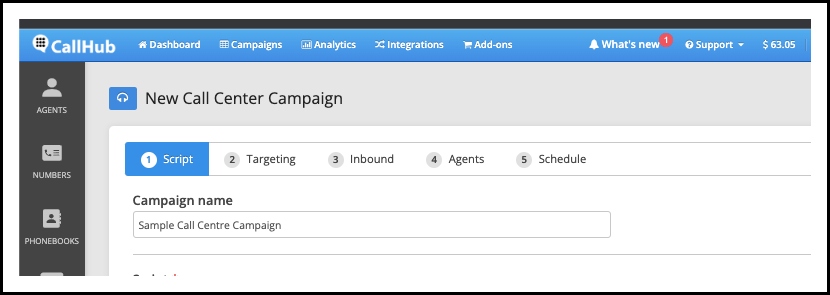

Step 2: Select the inbound call option.
The key factors influencing customer satisfaction are responsiveness, empathy, and assurance. Once you have entered your script and found your target audience, you move on to the ‘Inbound’ section.
Enable inbound calling and add a text or audio file that will play to indicate to a caller that they are on hold. You can also allow contacts outside your campaign to call you back.


Click on next.
Step 3: Set up criteria for call holding.
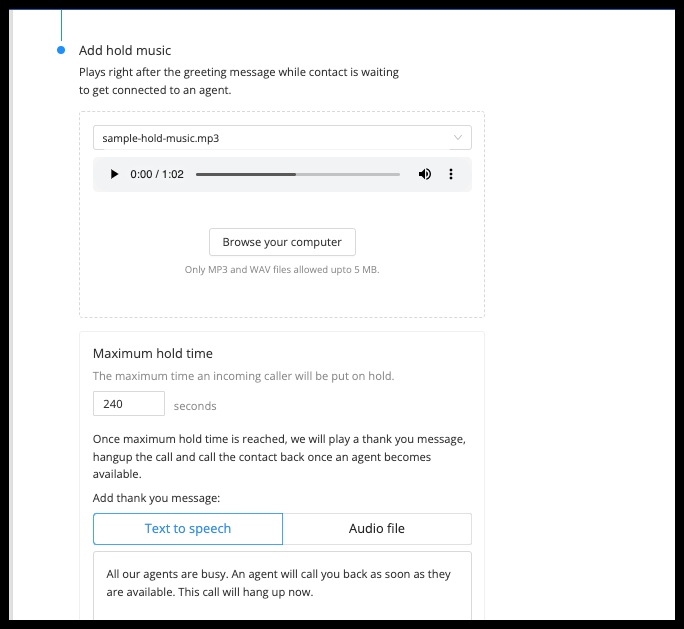

Here’s what you can do in this section–
- Use our sample hold music or upload a file to play when callers are on hold. According to a study by Jacob Jolij and Maaike Meurs from the University of Groningen’s Psychology Department, music significantly influences perception. The research reveals that individuals listening to happy music may perceive happy faces, and those listening to sad music may visualize sad faces, even without visual stimuli.
- Set maximum hold time. For example, if you set up the hold time for 240 seconds, and no agent answers within that time, the system will play a thank you message and hang up.
- Add a ‘thank you’ audio message or upload an audio file to play for callers.
And with this, you have set up call routing on CallHub. Complete the rest of the steps of the call center campaign, such as scheduling your campaign, and you are all set to go!
Call routing best practices
With the impact that call routing promises an organization, it is not only essential to set up one but to set it up in a manner that shows the best results.
Here’s how you can do that–
- Find the best call routing methods for your business.
- Upskill your agents.
- Combine call routing with other features such as analytics, call monitoring, etc.
Find the best call routing methods for your business
Finding the best call routing option depends on your business goals and what you want to improve or achieve.
Your business goals could look like-
- Improving agent productivity
- Enhancing customer experience
- Improving call center results
- Maximizing sales
- Creating customer self-service opportunities
Depending on your unique needs, you need to finalize the best call routing method.
Upskill your agents
If you are opting for skill-based call routing, you need to train different agents on the skills that are necessary to handle calls. Experienced agents need to know which complex issues they will be responsible for. Train newer agents in skills to eventually take on more complicated customer concerns.
Combine call routing with other features
While call routing is a very powerful feature, combining it with other call center tools drastically improves your call center.
Here are some call center features to explore:
- Call monitoring – Going through live or recorded calls to understand agent performance and bottlenecks in the calling process. On CallHub, you can use live call monitoring to dial in to any call in progress.
- Dynamic caller ID: You can use a dynamic caller ID to create a local presence in any geographical location. Callers can ring a local number, which is then routed to your call center. An independent study reveals that prospects are over four times more likely to answer calls when they originate from local numbers, resulting in a significant increase in contact rates from 10% to 40%. This emphasizes the considerable impact of using local numbers on the effectiveness of reaching and engaging with potential clients.
- Spam shield: Spam shield features help you avoid being labeled as spam. This increases the chances that a contact gives you a callback because you get a verified caller badge, which shows up on your customer’s phone screen when you call.
It’s time to upgrade your call center software
Features like call routing are only available on call center software made especially for campaigns and businesses.
This and various other tools and features work together to ensure your call center is successful.
Learn more about call center features that will enhance how your call center functions. Read our article, A Complete Call Center Software Buyer’s Guide, to learn more about these features.
Featured Image Source: Ksenia Kartasheva


